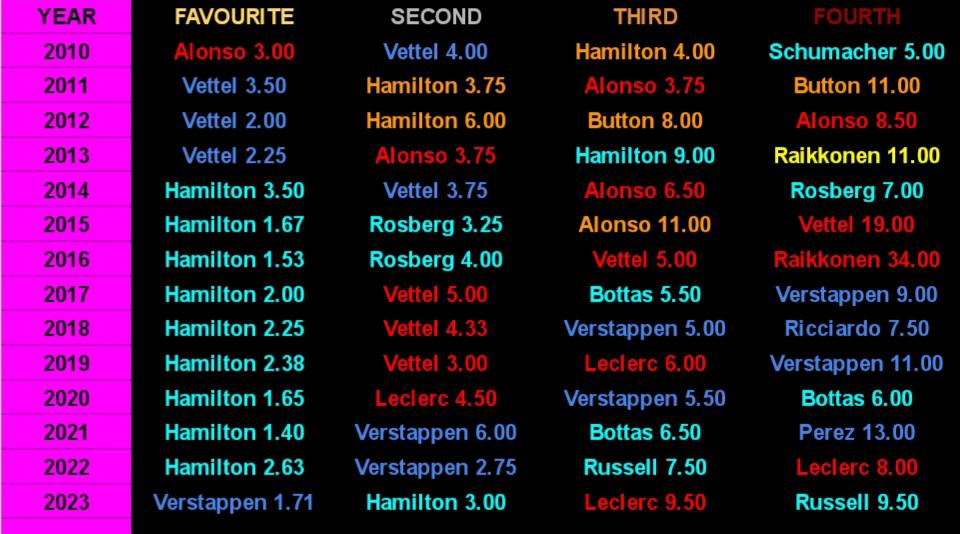Reading Formula 1 betting odds can be straightforward, especially if you have experience with betting on other sports. In the US, the “American format” is commonly used, where odds are displayed as a three-digit number with a “+” or “-” sign preceding it. Understanding these odds is crucial for making informed bets and maximizing your chances of winning.
American Odds Explained
In the American format, the odds are expressed with either a positive or negative number. Positive odds indicate how much profit you would make on a $100 bet, while negative odds indicate how much you need to bet to win $100. The smaller the number (whether positive or negative), the more likely the outcome is believed to be by the oddsmakers.
Example of Formula 1 Betting Odds
Let’s consider a typical display of Formula 1 odds for an upcoming Grand Prix:
- Lewis Hamilton: +120
- Max Verstappen: +130
- Valtteri Bottas: +800
- Sergio Perez: +1000
- Nicholas Latifi: +300000
In this case, Lewis Hamilton is the favorite to win, as indicated by his odds of +120. If you place a $100 bet on Hamilton, you would receive a total payout of $220 (your initial $100 stake plus $120 in winnings) if he wins. On the other end of the spectrum, Nicholas Latifi has odds of +300000, reflecting a 3000/1 chance of winning. A $100 bet on Latifi would result in a payout of $300,100 if he were to take the checkered flag first.
Factors Influencing Betting Odds
Several factors influence the odds set by bookmakers, including:
- Driver Performance: Recent form, historical performance at the track, and consistency throughout the season play a significant role in determining odds.
- Team Performance: The reliability and competitiveness of a team’s car are crucial. Teams like Mercedes and Red Bull typically have lower odds due to their track records.
- Track Characteristics: Some tracks favor certain driving styles or car setups. Bookmakers consider these nuances when setting odds.
- Weather Conditions: Weather can dramatically impact race outcomes. Wet conditions, for instance, often lead to unpredictable results.
- Qualifying Results: The starting grid determined during qualifying can significantly influence race-day performance and, consequently, the odds.
Strategies for Betting on Formula 1
To enhance your betting experience and improve your chances of winning, consider these strategies:
- Research and Analysis: Delve into drivers’ and teams’ past performances, particularly on similar tracks. Analyze qualifying results and practice session performances.
- Monitor Weather Forecasts: Weather can be a game-changer in Formula 1. Keep an eye on forecasts and factor in the likelihood of rain or other conditions affecting the race.
- Understand Track Characteristics: Some tracks are high-speed circuits, while others require high downforce. Match these characteristics with the strengths of the drivers and their cars.
- Value Bets: Look for discrepancies between your analysis and the bookmakers’ odds. Identifying value bets can lead to higher returns.
- Consider Long-Term Bets: Outright bets on the World Drivers’ Championship or Constructors’ Championship can be profitable if you correctly predict season-long performance trends.
Popular Formula 1 Betting Markets
Understanding the various betting markets can also help you diversify your bets:
- Race Winner: Betting on the driver who will win a specific Grand Prix. This is a straightforward market with varying odds based on the driver’s likelihood of winning.
- Podium Finish: Betting on a driver to finish in the top three. This market offers lower risk compared to betting on the outright winner.
- Fastest Lap: Betting on the driver who will set the fastest lap during the race. This market can provide higher odds and interesting opportunities.
- Pole Position: Betting on which driver will secure the fastest qualifying lap and start the race from pole position.
- Winning Margin: Betting on the time difference between the first and second-place finishers. This market adds another layer of excitement to the race.
Applying F1 Betting Strategies to Other Motorsports
Many of these strategies and principles can be applied to other motorsports such as MotoGP and NASCAR. Understanding the nuances of each sport, analyzing performance data, and staying informed about conditions and variables will enhance your betting success across different racing disciplines.
Conclusion
Betting on Formula 1 can be a thrilling and rewarding experience when approached with the right knowledge and strategies. By understanding how to read and interpret betting odds, conducting thorough research, and applying sound betting strategies, you can make informed decisions and increase your chances of success. Whether you are a seasoned bettor or new to the world of motorsport betting, these insights will help you navigate the exciting landscape of Formula 1 betting.
For more insights and betting opportunities on Formula 1 and other sports, visit https://jambobet.news/, your trusted source for the latest in sports betting and news.
ALSO READ:Mastering Formula 1 Betting: Strategies for Success


